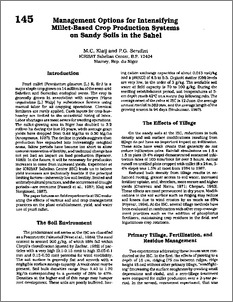Management Options for Intensifying Millet Based Crop Production Systems on Sandy Soils in the Sahel
Abstract
Pearl millet (Pennbelum glaucum (L.) R. Br.) is a major staple crop grown on 14 millton ha ofthe semi-arid Sahellan and Sudanian ecological zones. The crop is generally grown in association with cowpea (VLgna ungulculata (L.) Walpl by subsistence fanners using manual labor for all cropping operations. Chemlcal fertilizers are rarely applled. Cash Inputs for crop husbandry are llmited to the occasional hiring of labor. Labor shortages are most severe for weeding operations. The millet-growing area in Niger has doubled to 3.2 mllllon ha during the last 25 years, while average grain yields have dropped from 0.48 Mg/ha to 0.30 Mg/ha (Anonymous, 1987). The decllne in yields suggest8 that: productlon has expanded into lncreaaingly marglnal areas, fallow periods have become too short to allow natural restoration of fertlllty, and technical change hae not yet had an impact on food productlon (Spencer, 19851. In the future, it will be necessary for production increases to come from increased yields. Experience at the ICRISAT Sahellan Center (ISC) leads us to believe yleld increases are technically feasible if the principal limitlng factors-inherently low soil fertility, limited and untlmely cultural practices, and the occurrence of drought periods-are overcome (Fussell et at.. 1987: Klaij and Hoogrnoed, 1987)

